�

�
Road Test: MGB GT V8
�For : smooth, flexible engine; well-chosen gear ratios and overdrive;
�
roomy for two; good visibility.
�
Against : poor low-speed ride; haphazard instruments and controls;
�
dated decor; high wind noise at speed; rather expensive.
�
�
as published in British V8 Newsletter, Volume XV Issue 3, December 2007�
�
Re-printed unedited by exclusive written permission of "Motor".
�
This article originally appeared in their issue for the week ending August 25, 1973.�
�
�
Telling British Leyland what they ought to do has become a national pastime, and one �
of the most common demands (from Motor among others) as well as one of the mostly widely �
forecast events has been the marriage of the popular MGB GT body with Rover's 3.5 litre �
V8 engine. The two together seemed natural, especially after Ken Costello had shown the �
idea to be practical. �
�
Why then the delay? The answer is basically twofold. First British Leyland have to observe �
all the fine print in the regulations of the countries where the BV8 will be sold, a burden �
Mr. Costello does not share. It is interesting to note that the BV8 will not be sold in �
the States - the cost of Type Approval would presumably be prohibitive. Secondly, and �
possibly more important, buyers expect different standards when buying a modified car �
compared with a production model - and quite rightly too. They might forgive shortcomings �
in a modified car from a small specialist which they would find unacceptable from a large �
manufacturer. �
� With a two-year gestation period behind it, the BV8 has been a long time coming. And it � really is something of an enigma. Does one judge it as an uprated BGT or as an entirely � new car? On price it is firmly in the latter category, being expensive for a car which is � basically over 10 years old and which up to now has been in the £1600 class, even � though it more than holds its own in the performance stakes. So familiar though, are the � BGT and the Rover V8 that one tends to regard the V8 as an old friend transformed - and � what a transformation it is too. �
��
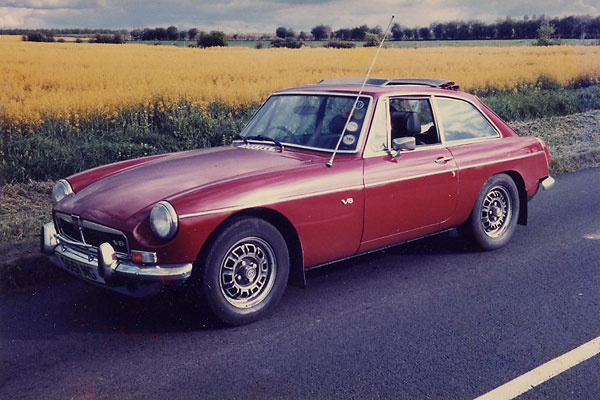
�
Ken Smith's MGB GT V8 (damask red / car number 1214)
�
�
Initial impressions are always illuminating, and among Motor's often cynical staff the �
reaction was quite enthusiastic. The BGT has always been regarded as a very attractive car; �
what it lacked, among other things, was performance and mechanical refinement. Even in its �
relatively de-tuned (one should say de-toxed) state the Rover engine certainly answers these �
two criticisms and gives the car a new lease on life. In most respects the combination is �
first class, combining the American idea of a large engine and straightforward suspension �
with European standards of compactness, steering and handling. The body itself is very �
strong - it was used as a base for one of the special cars sent to America recently as an �
example of British efforts on the safety front - so it did not require much strengthening �
to take either the extra power or to meet the now fairly rigid crash barrier tests of the �
EEC countries. The engine itself is no heavier than the B-Series it replaces, but the �
ancillaries are: the weight penalty is therefore only slight. As a corollary the suspension �
changes only had to take the increased torque into account. �
�
So appealing is the BV8 package that when the failings start to show themselves there is a �
sense of disappointment. Remembering that the car costs a hefty £2300, the ride, especially �
at low speeds, can only be described as poor, almost unacceptably so. Loud wind noise at �
anything above a modest cruising speed takes all the enjoyment out of the car on long runs �
and the dashboard layout is rather crude and austere, despite new fingertip switches and the �
introduction of face-level air vents (in 1972). Considering how much more expensive the BV8 �
is, one would have thought that British Leyland could have come up with a more modern, not �
to say ergonomic layout. �
�
In its price class the BV8 has some pretty strong competition. The Reliant Scimitar GTE has �
more usable internal space, is more attractive internally and rides better; the same can be �
said for the Datsun 240Z; and the roomier Capri 3000GT has a better ride if not handling. �
The Lotus +2S 130 (admittedly for a lot more money) provides similar performance with much �
superior standards of road-holding, handling and ride. �
�
As a poor man's Aston Martin V8, the new MG has a certain charm but we feel that modernization �
inside, even more performance (which might reasonably be expected from a 3 ½ litre 2-seater) �
and a smoother ride could have made it a worthy alternative to the Aston. �
�
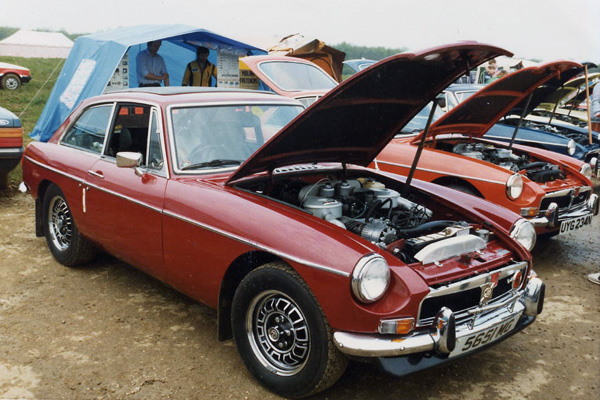
�
PERFORMANCE (4 of 5 stars)
��
To comply with the EEC emission regulations MG have opted for the low compression (8.25:1) �
variant of the Rover V8 with modifications. Relocation of the SU carburetters via a forked �
spacer manifold is claimed to give a slight increase in mid-range torque, but the main �
purpose of the move was to fit the carburetters under the standard bonnet. With a quoted �
output of 137bhp (DIN) at only 5000rpm the 3528 all alloy ohv engine displays the �
characteristic of its American ancestry in being relatively large and lightly stressed. �
Pump-up of the hydraulic tappets sets the upper rev limit at a lowly 5200rpm or thereabouts, �
so the engine is certainly not over-exerting itself. �
�
Considered as a 3 ½ litre sports car, the performance may be a little disappointing; it �
is nothing like as quick as the original 3.8 litre E-type for instance. When compared with �
others in its price class, however, the BV8's performance is very respectable indeed, and �
is considerably better than that of the standard BGT. Only the Morgan Plus 8 and the now �
discontinued Lotus Elan Sprint are faster to 60mph from a standing start, and only the Morgan �
(with the same engine and a lighter body) is anywhere near on top gear performance. �
�
What the bald figures cannot convey is the utter smoothness, the refinement and the lack �
of drama with which the unit performs, and the delightful surge when accelerating hard �
aided by the excellent engine-gearbox match which makes full performance easy to use. It �
would be difficult to make a rought car when going from a four to a V8, but the general �
opinion is that MG have done a thoroughly professional job properly engineered - and it �
shows. �
�
As you'd expect, the flexibility is remarkable, and 1000rpm in top gear is quite usable �
in traffic, the car waffling away steadily with the characteristic V8 burble. �
�
Starting (during the warm weather of our test) was immediate with a little choke, and warm-up �
rapid - the electric fans only came on when sitting for fairly lengthy periods in traffic jams. �
Idling was unobtrusive with only occasional lumpiness (again in jams) cured by a quick blip of �
the accelerator. Throttle action contributed to the overall smoothness, being light and progressive. �
�
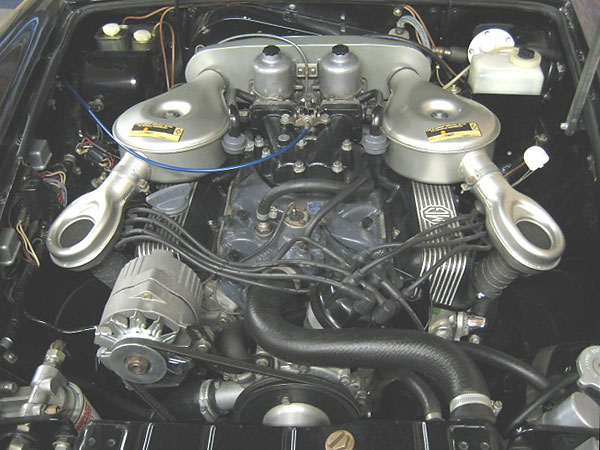
�
Dave Wellings' MGB GT V8 (black / car number 0974)
�
Economy (3 of 5 stars)
�� The overall consumption of just under 20mpg is similar to that of other cars in the same � price/performance class, but it can be achieved on 94 RON (three star) petrol, a bonus for � those who travel abroad, particularly in Germany where the lead content (the anti-knock � ingredient) in petrol is low. The engine ran quite happily on this grade with no sign of � pinking or run-on. With a 12-gallon tank the range is about 240 miles - barely acceptable � for a long run overseas. Oil consumption of 1000 miles per pint is more acceptable.�
�Transmission (4 of 5 stars)
��
The gearbox is a derivative of that used in the BGT, but with MGC ratios and modified bell �
housing to fit the V8 and its starter. Lever movements are short, precise, and very positive �
if a little stiff and notchy, but the latter characteristic should wear off with mileage - �
our demonstrator arrived with 1400 miles on the clock. The synchromesh was almost unbeatable �
but baulked snatched changes. Overdrive is standard, but only on top. There was quite a long �
delay before it came in too, but canceling was instantaneous, and the slight jerk could be �
eliminated by blipping the throttle or by dipping the clutch. The smooth and progressive �
clutch helps to make the engine and gearbox a good match without any really undesirable �
traits. Although clutch pedal load is higher than normal at 38lbs it does not feel too �
heavy - possibly a function of a good seat/pedal relationship. �
�
Intermediate speeds of 39, 61, and 96mph show the ratios to be reasonably spaced. At no �
time was the box noisy, nor was there any vibration, and tramp could be induced only during �
the most severe standing starts. �
Handling (3 of 5 stars)
��
To fit the engine it was necessary to move the steering rack forward slightly, making the �
steering lighter yet still direct and precise with a reassuring feel. Not that, by Lotus �
standards, is it light; parking calls for considerable effort and it appears to get heavier �
with lock. �
�
Just to remind you, the MGB was introduced in 1962, and the BGT in 1965. This fact probably �
more than any other explains the ride/roadholding/handling compromise of the BV8. The �
completely conventional layout it uses can still be made to work well, but only with proper �
location of the live rear axle which is still suspended on simple leaf springs. And of course �
a properly designed fully independent suspension would give much better results. �
�
Even so, the MG sets fairly high standards. The basic handling characteristic is understeer, �
since most of the roll stiffness is at the front; this may also account for the high level of �
traction at the rear in the dry. Power-on cornering can cause the tail to drift out so that �
when pressed the handling eventually changes to oversteer. Initial tyre break-away occurs at �
quite moderate cornering forces, and the ultimate cornering force is not exceptionally high. �
Where the GT V8 scores, and scores heavily too, is in its astonishing controllability and �
responsiveness - the oversteer can be used, and is great fun. In engineering terms the handling �
can be described as "fail-safe," being virtually self-correcting when the car gets out of line. �
Roll is hardly noticeable and has no direct effect on handling. In the wet the characteristics �
are accentuated somewhat, but the forgiving fail-safe capability still applies. The only time �
it gets a little uncomfortable is at speed on undulating surfaces, perhaps because of a trace �
of rear end steering. �
�
Although the GT V8 appears to be undisturbed by sidewinds, overtaking trucks on a motorway �
can cause a deviation from the straight and narrow, a problem with most cars.�
Brakes (3 of 5 stars)
��
To cope with the increased performance the brakes have larger calipers and thicker discs, �
and a servo is standard. Dual circuits are available only on those models for export to �
countries requiring them; in other words British buyers don't get this safety feature. �
�
The brakes were quite reassuring with barely noticeably fade at the top end of 20 half "g" �
stops, pulling up squarely on each occasion, although towards the end of the test there was �
quite a bad judder and some smell, with snatch when coming to rest. After the fade test, it �
felt as if "square drums" were fitted: with a steady pedal pressure there was a rhythmic �
binding roughly proportional to wheel speed. Only one application of the brakes was necessary �
to restore them to normal after soakingin a watersplash. �
�
The servo did not inspire much enthusiasm. Although nicely progressive (lack of progression �
often a fault with servos) the action was slightly inconsistent, and there was a degree of �
"self servoing" whereby, with the same pedal pressure, the braking force increased with �
decreasing speed - or, to put it another way, pedal pressure had to be reduced to maintain �
the same deceleration. With these minor reservations, the brakes behaved quite acceptably. �
Accomodation (4 of 5 stars)
�� Let's kill a myth once and for all: the plus-2 part of the BGT is to al intents non-existent, � the padded shelf behind the driver providing neither head nor leg room, and sitting sideways � is excruciating. Considered as a two seater (and we've star graded it as such) there is a useful � amount of luggage space (for a sports car) with 5.2 cu. ft. when the rear "seat" back is up or � 6.6 cu. ft. with it folded. Loading is easy via the large lift-up door and a flat floor at the � same level as the sill. There is a lockable glovebox on the passenger side, a map pocket in the � passenger's footwell, and a narrow armrest cum hinged box between the seat. Insertion of the � wider V8 has fortunately not meant any noticeable decrease in foot space, nor does any heat � seep through from the exhaust pipes.�
��
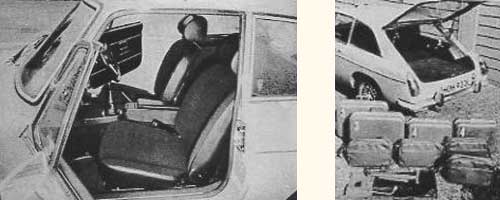
�
Above: with the rear seat folded flat 6.6 cu ft of luggage could be accomodated
�
Ride Comfort (2 of 5 stars)
�� The almost vintage nature of the suspension really shows up at low speeds, the ride being � harsh and lumpy even on relatively smooth surfaces. On rough roads ride deterioration is � yet more marked and can only be described as uncomfortable in the extreme - you steer around � bumps when possible. �
��
Enjoying this article? Our magazine is funded through the generous support of readers like you!
�
To contribute to our operating budget, please click here and follow the instructions.
�
(Suggested contribution is twenty bucks per year. Feel free to give more!)�
�
On the positive side, however, the ride improves with speed, notably on smoother (motorway �
type) roads, settling down to a taut rather than tight motion without any float - really �
quite pleasant. One feels, though, that increasing the rear spring stiffness to control �
the higher torque has conflicted with ride - and ride has lost out. And this in spite of �
a one inch increase in spring length at the front yet keeping to the same rates for both �
springs and anti-roll bar. �
�
Tyre thump was not particularly prominent, while low frequency pitch and bounce are �
naturally almost non-existent.�
Driver Comfort (3 of 5 stars)
�� All who tried the car found the seats comfortable, with plenty of fore and aft movement � and rake adjustment; when set up to suit the individual driver the head restraint could � be used as well to give a very relaxing position. �
��
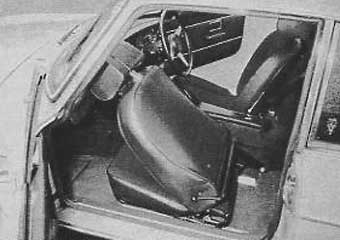 �
�
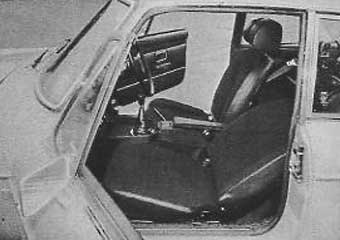
�
Above: the attractive seats could be adjusted both fore and aft and for rake, are well shaped, and are very comfortable
�
�
All the major controls fall, as they say, naturally to hand. The brake pedal/accelerator �
relationship seems to have been altered at last, and heel-and-toeing in now possible if �
not particularly easy - a definite improvement on the BGT. �
�
The minor control layout - knobs, buttons and so on - is in a real Jekyll-and-Hyde situation. �
Excellent stalk controls on the steering column operated the indicators/dip/flasher (right) �
and the wash/wipe/overdrive (left) - opinion on the latter was somewhat divided, some drivers �
feeling that the stalk had too much to do. The rest of the (mainly rocker type) switches are �
scattered around wherever there seems to be space, with the headlamp master switch almost �
hidden by the steering wheel rim, the heater controls over on the passenger side, and the �
hazard warning and rear screen switches and the cigar lighter at the bottom of the console, �
neatly obstructed by the gear lever. In general, the irritating trivialities outweigh the �
good points after a while. �
�
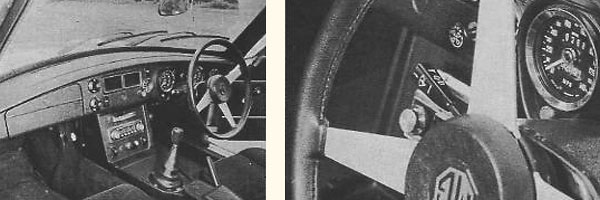
�
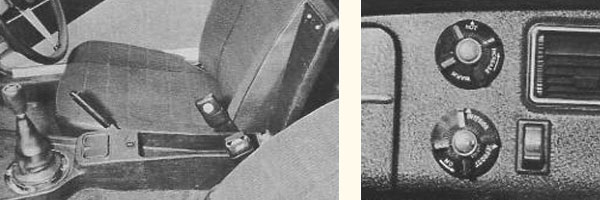
�
| Above: | (1) the fascia is uninspiring, being a mixture of old & new, |
| (2) the overdrive switch is neatly built into the wiper stalk, | |
| (3) a handy if narrow armrest / box, | |
| (4) the archaic heater controls. |
�
As on several other BL cars, to remove the key it must be pushed in, and at the same time �
a small button just underneath depressed. Once the knack was acquired it is easy - but �
heaven help women drivers with long fingernails!�
�
The inertial reel belts are comfortable, neither binding nor chafing. �
Visibility (4 of 5 stars)
��
Although you sit lower in the car than is usual these days, there is no sense of claustrophobia �
due to the large glass area of the Sundym glass; visibility is excellent all round with �
no real blind spots thanks to the (dipping) interior mirror and the door-mounted wing mirrors.�
�
On high beam the headlights are very good, powerful, and with a wide if fuzz-edged beam. �
Dip, on the other hand, seemed to have the power of an undersized glow worm, and was �
inadequate for anything over about 30mph. The reversing light is standard and parking �
simplified by the front wings which are proud of the bonnet line; the rear bumper is �
only a few inches beyond the opening rear tailgate. �
Instruments (2 of 5 stars)
�� One supposes that in the interests of metrication the instrument dial diameters were � reduced from 4in. (about 100mm) to mean little 80mm ones, a retrograde step. Otherwise � all is as before: unexceptional. For the price - and considering some of the delightful � layouts on other BLMC models - the whole of the dashboard, and come to that, the whole � of the interior, could have been updated and modernized. To its credit, there is no � reflection and the lighting could be controlled by a knob on the dashboard. Full brightness � is still not very powerful. �
�Heating and Ventilation (2 of 5 stars)
��
We had no opportunity to test the heater during the time we had the car since it coincided �
with fairly warm weather. Which is probably just as well since the heater controls can �
only be described as antediluvian. The top rotary knob which controls the temperatures �
was stiff and reluctant to turn off: the lower one did not seem to serve any useful �
purpose at all, since there was very little difference between the "interior" and "defrost" �
(and that word indicates just how old the controls are - from the Austin A60 in fact) �
settings. The fan was reasonably quiet. �
�
The two center vents provided a reasonable flow so long as the rear three-quarter windows �
are open, and so long as the car is in motion. There is no fan boost. They also, if �
pointed downwards, scattered cigarette ash throughout the interior if one had the �
temerity to use the ashtray. Not one of the better points of the car. �
Noise (2 of 5 stars)
��
Perhaps the worst feature of the BV8 is wind noise. At 60mph it is noisy, at 70 it is �
very noisy; and above this speed it makes fast runs a misery, and a radio a mockery, �
hence only two stars. Almost every pane of glass except windscreen and rear window �
contributes to the general level. This is all the more disappointing since the engine �
and transmission are remarkably quiet even at high revs, when a muted induction roar is �
the most prominent sound. This aspect alone rather spoils the car as a trans-Continental �
express for which it would be otherwise well suited. At lesser speeds, especially around �
town, we'd upgrade the car to four stars.�
�
Perhaps out model was still prototypical since it suffered from various other noises as �
well. Accelerating in first, and gently at that, produced a zing in the steering column �
which seemed to be produced by the engine twisting under torque and allowing the exhaust �
pipe to touch the column. The electric fans, alleged to be quieter and smoother than the �
belt-driven type, in fact rumbled loudly when operating and in addition shook the car! �
There was also a temporary squeak from the clutch release bearing which, however, �
disappeared after a while. �
Fittings and Finish (3 of 5 stars)
��
Aesthetically the interior is a strange mixture of the old and the new, with cloth covered �
seats, a moulded console, and "everything fake" modern steering wheel and air vents �
contrasting with the haphazard scattering of the controls, the black crinkle finish of �
the dashboard (complete with a pointless stray chrome strip across the glovebox) and the �
generally late-Fifties dash layout. �
�
The tunnel covering is reasonably plush-looking carpet with rubber floor mats, and the �
whole of the luggage space is carpeted well if a little loosely. The rear "seat" is cloth �
covered to match the front seats, in this case in an attractive shade of dark blue. Fit �
and finish in general was quite good. �
�
The list of standard equipment is fairly comprehensive, and included Sundym glass, matt �
black arms for the two-speed wipers, a heated rear window, a cigar lighter, a dipping rear �
view mirror and overdrive, to name only some. �
�
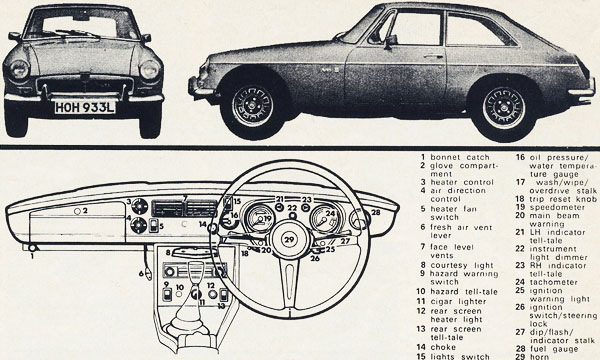
�
In Service
��
The bonnet opening knob is buried above the passenger's shin; once open the accessibility �
is surprisingly good, with only the plugs hidden within the convolutions of the exhaust pipe. �
Removal of the air cleaners, though, should make them easier to reach. The amount of space �
around the engine is also quite surprising - no shoe horn job this, even if one or two �
clearances are a bit tight. The quality of the engine is pure Rover, as is to be expected, �
which does rather show up the MG (ie Austin/Morris) bits that surround it. �
�
The spare wheel lives in a depression under the carpet in the back, while the pathetic tool �
kit (jack and wheelbrace) are housed in what appears to be a tatty bit of old carpet. Battery �
topping up is a real chore, the two six volt batteries sitting under the back seat, which has �
to be removed, along with an additional panel, before they are accessible. �
�
Underbody protection consists of the basic electrophoretically applied paint and a bitumastic �
compound in the wheel arches and in other strategic areas. The well deserved reputation MGs �
have for longevity would seem to make this model a suitable candidate for one of the �
proprietary rust prevention systems. �
�
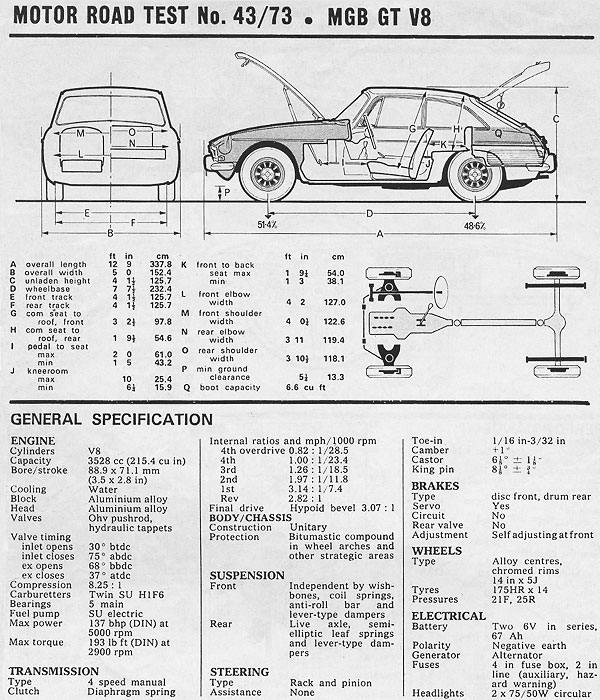
�
Comparisons
�| Capacity | Price | Max | 0-60 | 30-50 | Overall | Touring | Length | Width | Weight | Boot | |
| cc | £ | mph | sec | sec | mpg | mpg | ft in | ft in | cwt | cu ft | |
| MGB GT V8 | 3528 | 2309 | 125.3 | 7.7 | 6.2 | 19.8 | 25.7 | 12' 9.0" | 5' 0.0" | 21.2 | 6.6 |
| Ford Capri 3000 GT | 2994 | 1651 | 119.5 | 8.6 | 7.7 | 19.4 | 24.7 | 14' 1.0" | 5' 5.0" | 21.1 | 7.8 |
| Lotus Elan +2S (4spd) | 1558 | 2708 | 121.0 | 7.7 | 8.5 | 21.0 | 26.1 | 14' 0.5" | 5' 3.5" | 16.8 | 4.2 |
| Lotus Elan Sprint | 1558 | 2436 | 121.0 | 6.7 | 7.8 | 22.2 | 30.5 | 12' 1.25" | 4' 8.0" | 13.6 | 3.1 |
| Datsun 240Z | 2392 | 2535 | 125.1 | 8.3 | 9.0 | 25.7 | 31.2 | 13' 7.0" | 5' 4.0" | 20.3 | 11.4 |
| Morgan Plus 8 | 3528 | 1966 | 125.0 | 6.7 | 4.8 | 20.3 | 22.2 | 12' 9.0" | 4' 9.75" | 17.2 | 4.4 |
| Reliant Scimitar GTE | 2994 | 2480 | 113.2 | 10.2 | 7.9 | 19.2 | 27.9 | 14' 2.25" | 5' 5.0" | 22.7 | - |
| Triumph Stag | 2997 | 2533 | 116.5 | 9.7 | 7.6 | 20.9 | 25.5 | 14' 6.75" | 5' 3.5" | 25.9 | 3.6 |
| MGB GT | 1798 | 1547 | 107.6 | 11.6 | 8.8 | 27.4 | 33.0 | 12' 9.0" | 5' 0.0" | 20.1 | 6.6 |
�
� When Motor originally published this article, they illustrated it with fourteen black-and-white � photos of a light-colored MGB GT V8 bearing registration plate "HOH 933L". We've included ten of � those original photos here, plus two newer color photos of Ken Smith's damask red MGB GT V8� and one photo of Dave Wellings' immaculate engine bay.�
��
� BritishV8 Magazine has assembled the largest, most authoritative collection of MG � "MGB GT V8" information you'll find anywhere. Check it out! � Access our � MGB GT V8 article index by clicking here. �
�

